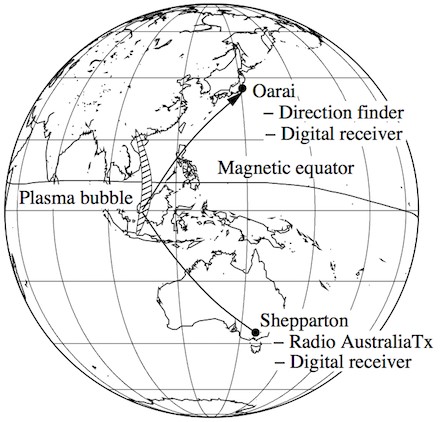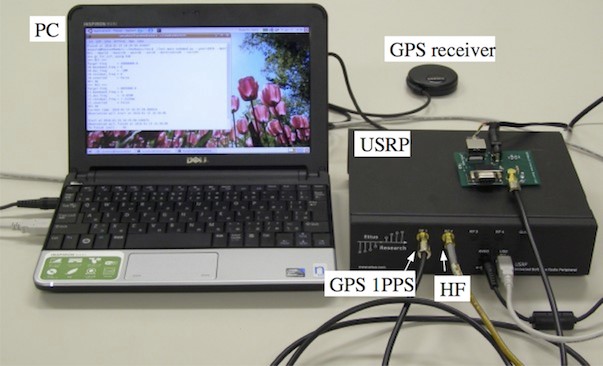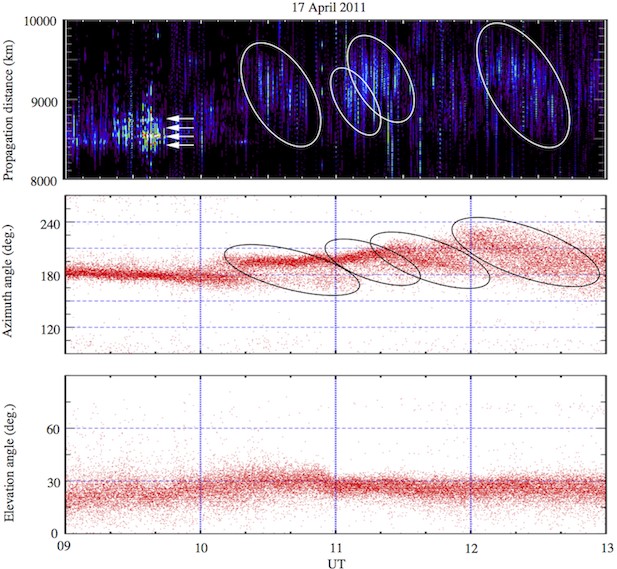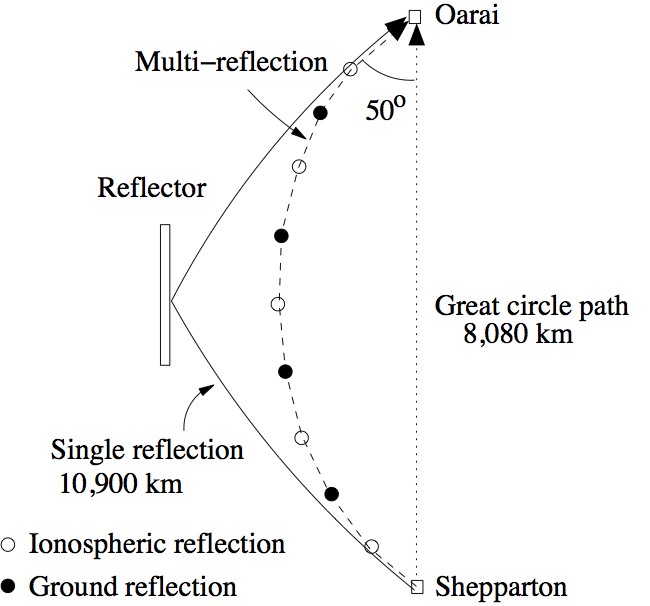Susumu Saito(National Institute of Maritime, Port and Aviation Technology)
Plasma bubbles are ionospheric disturbances that occur in the magnetic low latitude region. They are generated at the magnetic equator after sunset by a plasma instability called Rayleigh-Taylor Instability, with which regions of low plasma density like a “bubble” develop along the earth’s magnetic field lines and rises to higher altitudes. At the same time, they expand poleward. At the boundaries of plasma bubbles, the ionospheric plasma density suddenly changes. Inside the plasma bubble, plasma irregularities with different scale sizes are generated by secondary plasma instabilities. Sudden change of plasma density in space makes differential correction of GNSS (Global Navigation Satellite System) difficult. Plasma irregularities makes amplitudes of radio waves in frequency bands from VHF to L-band fluctuate and makes reception of satellite radio signals difficult. This is called “amplitude scintillation”. Thus, it is an important task to monitor the plasma bubble occurrence, trace them, and predict their generation, because they cause difficulty in various radio applications.
Trans-equatorial propagation (TEP) of radio waves in HF to VHF bands between a pair of a transmitter and receiver located at each side of the magnetic equator has been used to observe generation and propagation of plasma bubbles. In TEP observations, arrival angles of radio waves transmitted from one side of the magnetic equator are measured by the receiver. Since plasma bubbles are structures narrow in the zonal direction and elongated in the meridional direction, they work like a reflector. Therefore, TEP radio waves often arrive at the receiver in directions away from the great-circle direction of the transmitter. As plasma bubbles move (normally eastward), the arrival angles also change gradually. National Institute of Information and Communications Technology installed an HF direction finder (HF-DF) at Oarai (36.3ºN, 140.6ºE), Japan and has observed arrival angles of radio waves transmitted from Shepparton (36.2ºN, 145.3ºE), Australia by Radio Australia to monitor the plasma bubble occurrence and its propagation speed [1]. Observation of TEP of broadcast radio waves is suitable for wide-area monitoring of plasma bubbles, because one single receiver can monitor a wide-area. It is also an advantage of using broadcast waves that no dedicated transmitter is necessary.
However, actual propagation paths cannot be determined by arrival angle measurements only. Therefore, plasma bubble location and velocity were estimated by assuming a single side reflection by a plasma bubble as a plane reflector, and the estimated location and velocity would have significant errors. Indeed, Tsunoda et al. [2, 3] showed that estimated drift velocities were sometimes unrealistically fast. They suggested that radio waves may propagate by gradually changing propagation directions by repeating reflections between the ground and inclined ionosphere, not by a single side reflection by the plasma bubble.

Figure 1. Measurements of HF TEP of Radio Australia broadcast waves [4].
In this study, in addition to arrival angles, propagation times of Radio Australia signals transmitted from Shepparton, Australia to Oarai, Japan by a pair of software-defined radio receivers (SDRs). One SDR was located just by the transmitter antenna and the other SDR was co-located with the HF-DF at Oarai. They recorded the Radio Australia signals simultaneously (Figure 1) [1]. The two SDRs were time-synchronized by using GPS clocks whose error is less than 1 microsecond (Figure 2). Observations made in 2011 showed that the measured virtual propagation distance (converted from propagation time by using the speed of light in the vacuum) of Radio Australia signals (9.475 MHz) suddenly increased by 1500 km, when the arrival angle at Orai jumped west by up to 50 degrees. As the arrival angles gradually move to the south, the virtual propagation distances gradually decreased (Figure 3). Furthermore, the measured virtual propagation distances are much shorter than those which would have been with the single side reflection by the plane plasma bubble (by 1000 km). This supports the view of HF TEP with multiple
reflections between the ground and the inclined ionosphere.

Figure 2. An HF receiving system based on an SDR (Universal Software Radio Peripheral: USRP) [4]. Signals from an HF antenna and 1 PPS (pulse-per-second) signals are received simultaneously by a two-channel receiver and recorded by a PC.

Figure 3. HF TEP observation results on 11 April 2011. From top to bottom, the virtual propagation distance virtual propagation distance (converted from the propagation time by using the speed of light in the vacuum) and the azimuth and elevation angles of arrival at Oarai are shown. Without plasma bubbles before 10 UT, azimuth angles of arrival are constant around the great-circle direction, and multiple discrete groups of the propagation distances (presumably corresponding to the different number of hops between the ground and the ionosphere) can be seen. After 10 UT, four groups of azimuth angles of arrival where they change from the west to south, presumably corresponding to plasma bubbles can be seen. Corresponding to them, the propagation distances also show four groups changing from 9500–10000 km down to 8700 km.

Figure 4. HF TEP models with a plasma bubble, a single side reflection where a plasma bubble is considered as a plane reflector, and a multiple-refection model where HF waves propagate with multiple reflections between the ground and the inclined ionosphere [4]. For the single side reflection model (1), the HF propagation distance must be larger than the distance along the earth’s surface (10800 km), but the observed propagation distances are much shorter than this. With the multi-reflection model (2), HF radio waves can arrive at Oarai with shorter propagation distances.
The results of this study suggest that propagation time measurements together with the arrival angle measurements give more information on the paths of TEP and could improve the accuracy of estimation of plasma bubble location and propagation velocity. It should also be noted that the propagation time measurements are realized by low cost SDRs to make multi-location observation with multi-transmitting stations easier.
The radio propagation subgroup of the PSTEP Group A01 is developing an HF radio propagation simulator by using a ray-racing method. It is expected to be able to simulate HF TEP to verify the hypothesis that HF radio waves propagate with multiple reflections between the ground and the inclined ionosphere, when plasma bubbles exist. The goal is to estimate the location and propagation velocity of plasma bubbles more accurately, by searching a best propagation paths for the measured HF TEP arrival angle and propagation time by the HF propagation simulation. It is also important to validate the results of the HF propagation simulator. Measurements of propagation times of HF broadcast waves from stations in Japan by SDR-based receivers are being conducted to compare the results with those predicted by the HF propagation simulator. Results of the measurements and validation results will be reported on the next opportunity.
References
[1] Maruyama, T., and Kawamura, M., Equatorial ionospheric disturbance observed through a transequatorial HF propagation experiment. Annales Geophysicae, 24, 1401–1409, 2006.
[2] Tsunoda, R., Maruyama, T., Tsugawa, T., Yokoyama, T., Ishii, M., Nguyen, T. T., Ogawa, T., and Nishioka, M., Off-great-circle paths in transequatorial propagation: 1. Discrete and diffuse types. Journal of Geophysical Research: Space Physics, 121, 11,157–11,175, https://doi.org/10.1002/2015JA021695, 2016a.
[3] Tsunoda, R., Maruyama, T., Tsugawa, T., Yokoyama, T., Ishii, M., Nguyen, T. T., Ogawa, T., and Nishioka, M., Off-great-circle paths in transequatorial propagation: 2. Nonmagnetic-field-aligned reflections. Journal of Geophysical Research: Space Physics, 121, 11,176–11,190. https://doi.org/10.1002/2016JA022404, 2016b.
[4] Saito, S., Yamamoto, M., and Maruyama, T., Arrival angle and travel time measurements of HF transequatorial propagation for plasma bubble monitoring, Radio Science, 53. https://doi.org/10.1029/2017RS006518, 2018
